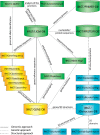IMGT, the international ImMunoGeneTics information system
- PMID: 18978023
- PMCID: PMC2686541
- DOI: 10.1093/nar/gkn838
IMGT, the international ImMunoGeneTics information system
Abstract
IMGT, the international ImMunoGeneTics information system (http://www.imgt.org), was created in 1989 by Marie-Paule Lefranc, Laboratoire d'ImmunoGénétique Moléculaire LIGM (Université Montpellier 2 and CNRS) at Montpellier, France, in order to standardize and manage the complexity of immunogenetics data. The building of a unique ontology, IMGT-ONTOLOGY, has made IMGT the global reference in immunogenetics and immunoinformatics. IMGT is a high-quality integrated knowledge resource specialized in the immunoglobulins or antibodies, T cell receptors, major histocompatibility complex, of human and other vertebrate species, proteins of the IgSF and MhcSF, and related proteins of the immune systems of any species. IMGT provides a common access to standardized data from genome, proteome, genetics and 3D structures. IMGT consists of five databases (IMGT/LIGM-DB, IMGT/GENE-DB, IMGT/3Dstructure-DB, etc.), fifteen interactive online tools for sequence, genome and 3D structure analysis, and more than 10,000 HTML pages of synthesis and knowledge. IMGT is used in medical research (autoimmune diseases, infectious diseases, AIDS, leukemias, lymphomas and myelomas), veterinary research, biotechnology related to antibody engineering (phage displays, combinatorial libraries, chimeric, humanized and human antibodies), diagnostics (clonalities, detection and follow-up of residual diseases) and therapeutical approaches (graft, immunotherapy, vaccinology). IMGT is freely available at http://www.imgt.org.
Figures

References
-
- Lefranc M.-P, Lefranc G. The Immunoglobulin FactsBook. London, UK: Academic Press; 2001. pp. 1–458.
-
- Lefranc M.-P, Lefranc G. The T cell receptor FactsBook. London, UK: Academic Press; 2001. pp. 1–398.
-
- Giudicelli V, Lefranc M.-P. Ontology for Immunogenetics: the IMGT-ONTOLOGY. Bioinformatics. 1999;12:1047–1054. - PubMed
-
- Lefranc M.-P. Nomenclature of the human immunoglobulin genes. In: Coligan JE, Bierer BE, Margulies DE, Shevach EM, Strober W, editors. Current Protocols in Immunology. NJ, Hoboken: John Wiley & Sons, Inc.; 2000. pp. A.1P.1–A.1P.37.
Publication types
MeSH terms
Substances
LinkOut - more resources
Full Text Sources
Other Literature Sources
Miscellaneous

